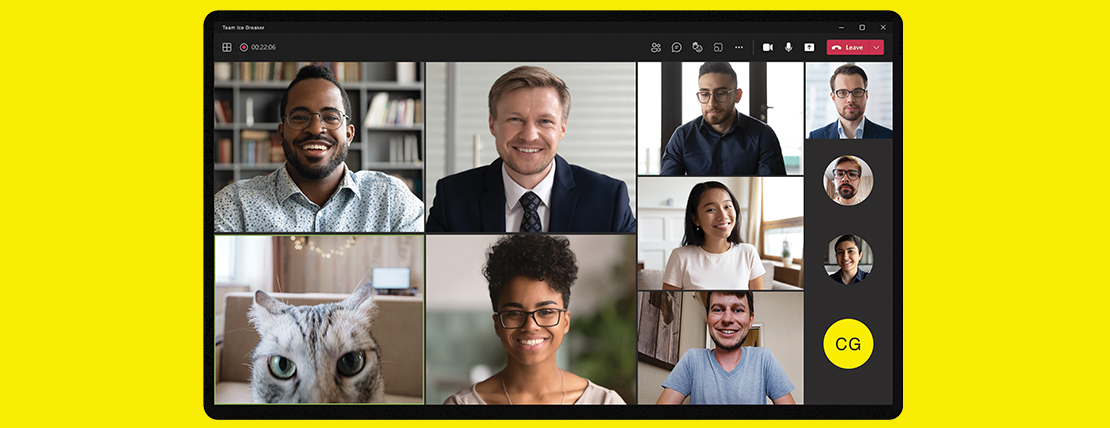Stuart Curtis picked a heck of a time — the onset of the covid-19 pandemic last March — to start his position as Global Director of Learning and Development at Workhuman, a Framingham, mass-based provider of social recognition and continuous performance management software. Talk about diving headfirst into shark-infested waters in a breathtaking swirl of worldwide uncertainty.
“At the time, we didn’t know how long the sustained work-from-home period would last, but knew it would be substantial,” said Curtis. As a result, the company had to change its in-person delivery model for employee learning and training to quickly upskill and facilitate personal development sessions over Zoom and other video conferencing methods.
“While our focus has always been on infusing training with humanity and human connection, COVID led to our focus really being on interpersonal communication, changing the pace and tone of our interactions, and taking a holistic approach, rather than a siloed approach to training,” he continued.
“In many ways, COVID and its impacts on where people work, how they connect with each other and how agile we need to be really just rein- forced the already-accelerating trends in learning,” added Andrea Elkin, vice president of enterprise learning at ADP.
Elkin noted several trends, including:
- Selecting the best blend of learning modality (such as instructor-led training, on-the-job training, coaching, e-learning, video and knowledge management); and
- Accelerating ways to meet learners in their flow of work by providing assistance right at the point of need.
This integration of learning, knowledge management and performance support is forging a new, holistic path to continuous learning, said Elkins. “Personalization is key in this.”
Employees, managers and heads of learning and development will likely agree that the biggest deterrent to continuous learning is the time it takes, she said.
“We have more data now than ever about what people want in learning — and we know that they want it to be timely, targeted, adaptive and fast.”
Pre-COVID, there was a movement toward increased utilization of technology, such as virtual reality, augmented reality and artificial intelligence in the training industry, added James Guilkey, PhD., president of Columbus, OH based S4 NetQuest, a custom learning solutions provider.
“COVID’s forced the use of ‘virtual’ technologies such as Zoom. But the issue isn’t about technology, it’s about instructional design. The technology is a vehicle, not the solution.”
Zoom, for example, allows his company to do video conferencing. That said, using Zoom to lecture to Power Point slides isn’t an effective learning solution, he explained. “Having learners interact via Zoom, solve problems, complete learning activities within an online learning community are the keys to ultimate success.”
In the eye of the pandemic, Guilkey’s firm also changed its onboarding process. “We’ve welcomed 200 humans to Workhuman since the start of the lockdown situation. Onboarding’s now done virtually. We’ve changed the pacing of this process since it is not face-to-face as a way to give new employees time to adjust to their new role. “
The pandemic also has impacted his organization’s approach to icebreakers, said Curtis. “Typically, we’d always have an energizing icebreaker in the room when delivering a training in-person. But now we’re not in a physical room; we’re in 20 or 30 virtual rooms. We use methods to make sure people participate early in any training session. “
One example: using binary pictures and asking each learner to describe which they are more like before they nominate the next person. “The practical result is people have a little fun to break the ice, and everyone speaks within the opening minutes of any training, so anyone who is a little more introverted or quiet does not feel awkward speaking up later,” he noted.
Furthermore, Guilkey believes that once organizations realize that virtual training can be effective when designed correctly, the amount of in-person classroom training will see a steady decline.
So, how are employers carrying out the planning and delivery of employee training and development to ensure they have the skills and knowledge to keep growing professionally?
According to a recent study by Gartner, the skills required for a single job are increasing by 10% year over year, and more than 30% of the skills needed three years ago will soon be irrelevant. The IBM Institute for Business reported that 120 million workers would need reskilling over the next three years. And, according to LinkedIn Learning, 94% of employees would stay at a company longer if it invested in their learning and development.
This is reinforced by Gartner, which also reported that Gen Z is the first generation to value development over compensation.
"Typically, we’d always have an energizing icebreaker in the room when delivering a training in-person. But now we’re not in a physical room; we’re in 20 or 30 virtual rooms. We use methods to make sure people participate early in any training session.”
Elkins said the data reflects “an enormous shift” in perceptions of learning, and a realization that learning and development today is more critical than ever. “The first step to making positive change is realizing and admitting that you have a problem,” Elkins said. “Companies that don’t realize how imperative the continuous learning journey is will risk losing good people and losing their competitive edge. Once you recognize the need for a continuous learning journey, you can implement it by focusing on three parts; I like to think of them as three legs of a stool.”
For his part, Guilkey doesn’t believe they’re doing so well. “Organizations are attempting to combine technology with traditional training methods.” Take the use of Zoom meetings to lecture to Power Point slides (traditional lecture method), for example. Organizations must realize that the virtualization of training requires an innovative, highly effective instructional design methodology to ensure overall learning will occur, he added.
Pre-work such as self-paced eLearning micro-modules combined with interactive, problem-based learning activities must be properly blended to ensure effectiveness when being deployed virtually, he continued.
Perhaps not surprisingly, especially in the wake of COVID- 19, companies have modified the way they deliver employee learning and training in the last year.
“In the wake of COVID-19, we transitioned from traditional to virtual learning on a dime,” said Elkins. “Combined with digital transformation efforts, this brought an openness to a more agile, iterative way of working.” The concept of producing a minimal viable product and immediately assessing, advancing and iterating the solution helped her company realize it can work faster while maintaining quality.
“Not only has the move to virtual learning continued to flip the classroom toward facilitation and coaching, but it has brought an explosion of vendors and options that were not there in the past,” said Elkins. “We have more opportunities than ever to experiment with concepts such as adaptive and AI instructional design, and external tools and solutions (such as Zoom) that make learning available to everyone.”
Guilkey said the last year has highlighted several critical deficits in corporate training as well. For example, traditional corporate in-person classroom training remains focused on the trainer and delivered via a basic lecture format — “the sage on the stage.” While this technique alone isn’t a highly effective learning methodology, the weaknesses became glaring when COVID-19 forced the use of this same approach in a virtual distribution format, he explained.
“To assume individuals will sit in their home offices and listen to trainers lecture to Power Point slides via a Zoom meeting for hours on end is a complete disaster,” said Guilkey. K-12 is experiencing the same challenge. Instead, organizations must “transform” their current in-person training to ensure effectiveness for virtual distribution.
That’s not easy, he noted, because most training is both designed and delivered by subject matter experts. Although SMEs have a thorough knowledge of a particular content set, they have little or no knowledge of instructional design and the associated learning theories. Program transformation should include a blended approach to learning:
- Self-paced eLearning modules. Converting a portion of the training into self-paced eLearning modules. Foundational knowledge is a good candidate for conversion to eLearning. SMEs struggle with trying to convert their content into effective self- paced learning modules. They normally create a “page-turner” where learners read and then take a test.
- Problem-based learning. Putting the impetus and responsibility for learning on the learners, rather than the trainer. Problem-based learning’s an effective method for engaging the learner and forcing them to assume responsibility for their learning. Give them a problem to solve and the appropriate resources to develop a solution. SMEs, as trainers, feel responsible for the learning effectiveness.
- Collaboration. Create learning communities where learners can collaborate, solve problems and share the learning experience. This requires SMEs to abandon their lecture format and, instead, facilitate learning activities.
- Facilitation. Having the trainer become a facilitator. Rather than simply lecturing to Power Point slides, have the trainers facilitate learning activities, add expertise and be available for support. This is a difficult transition for many trainers.
- Application of skills. Ensuring learning outcomes are focused on application of skills rather than simple memorization of information and associated test scores. Most learning effectiveness is measured through standard testing (i.e., multiple-choice questions). This promotes rote memorization. Problem-based learning and collaboration ensures application of knowledge and skills.
"To assume individuals will sit in their home offices and listen to trainers lecture to Powerpoint slides via a zoom meeting for hours on end is a complete disaster.”
Looking forward, it’s important to realize that pendulums swing, said Elkins.
“It’s not all or nothing, and we can’t assume that classroom learning won’t continue to be a part of our learning toolkit. There’s still value to be gained from dedicated, undistracted time for learning; it just needs to be leveraged and targeted with great purpose.
“People learn from each other and, over the long run, benefit from a balance of virtual and face-to-face opportunities for learning, building relationships and sharing experiences. This is especially true for newer employees.”
Fueled by the pandemic, companies will be forced to not only rethink their current training approaches, but also ensure resiliency and sustainability in the future, said Guilkey. Approaches will include:
- Continued use of virtual training. When designed correctly, utilizing a blended learning approach, virtual training can be highly effective. In addition, virtual training reduces overall expenses, such as travel, trainer time, facility rental and loss productivity.
- Increased use of technology. Increased use of learning-centric technologies such as virtual meetings (i.e., Zoom), web-based eLearning modules, performance support apps and artificial intelligence.
- Just-in time learning or learning at the point of application. (i.e., performance support apps). Don’t train associates on skills they won’t be able to apply for six or seven months. Instead, have associates access the required knowledge and skills just prior to needing it, through the use of technology and innovative instructional design.
Guilkey also foresees AI as the next step in learning innovation. “We’re training surgeons and surgical staff on the use of a new digital surgical robot platform. The platform records a wide variety of surgeon inputs.
This information can then be used to customize training.”
Through AI, for example, “the system notices that a surgeon’s taking an inordinate amount of time to tie a specific surgical knot,” he said. “The system can alert the surgeon and ask if the surgeon would like additional remediation, such as watching a video, viewing step-by- step instructions, or talking with an experienced surgeon.”







